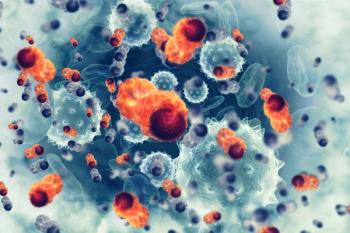
Oncology NEWS International
- Oncology NEWS International Vol 6 No 1
- Volume 6
- Issue 1
Goals of Planned National Pain Research Consortium Outlined
WASHINGTON--An announcement by NIH director Harold E. Varmus, MD, of a plan to form a national pain research consortium came as a complete, but pleasant surprise to the American Pain Society, Martin Grabois, MD, president of the Society, said in an interview with Oncology News International.
WASHINGTON--An announcement by NIH director Harold E. Varmus, MD, ofa plan to form a national pain research consortium came as a complete,but pleasant surprise to the American Pain Society, Martin Grabois, MD,president of the Society, said in an interview with Oncology News International.
In his keynote address at the Society's Annual Scientific Meeting, Dr.Varmus said that the consortium will comprise representatives from variousbranches of the NIH, including, but not limited to, the National Instituteof Neurological Diseases and Stroke, National Cancer Institute, NationalInstitute on Aging, and National Institute of Arthritis and Musculoskeletaland Skin Diseases.
Dr. Varmus said that the consortium would serve as a centralized clearinghousefor projects and information on pain, help to publicize the aims and accomplishmentsof pain specialists, and foster collaboration and dialogue among scientists,pain societies, advocacy groups, and other members of the pain community.
Proposed Functions of the Planned NIH Pain Research Consortium
Dr. Grabois, professor and chairman of physical medicine and rehabilitation,Baylor College of Medicine, said that the Society was very enthused bythe announcement. If the consortium carries out the goals and functionsDr. Varmus described in his talk (see table above), he said, "I thinkthat would go a long way toward upgrading pain research conducted at NIHor with NIH support." However, he noted that Dr. Varmus included notime frame for the formation of the consortium. "We would like tosee how the plan is implemented and take a look a year later to see howwell the consortium's stated goals have been met."
Charles S. Cleeland, PhD, outgoing president of the Society, said thatthe consortium would bring a "needed level of coordination of painresearch at the NIH." He added that he hoped the consortium "willlook for advice and counsel from the community of patients who suffer painand the professionals who try to help these patients."
Articles in this issue
almost 29 years ago
New Board to Deal With Cancer Policy Issuesalmost 29 years ago
MoAb Shows Positive Results in Lymphoma Patientsalmost 29 years ago
Prostate Cancer Gene Location Narrowed to Chromosome 1 Armalmost 29 years ago
New BCG Bladder Cancer Indication Gets Panel Nodalmost 29 years ago
Panel Advises FDA To OK Letrozole for Advanced Breast Canceralmost 29 years ago
Limited Diagnostic Testing After Breast Cancer Treatment Urgedalmost 29 years ago
Pressures of Managed Care Spur Interest in Clinical Guidelinesalmost 29 years ago
Baltimore Will Head New Effort To Develop a Vaccine for HIValmost 29 years ago
Epidemiologist Challenges Tamoxifen, Second Cancer Linkalmost 29 years ago
Cancer Care's AIDS Pain Booklet AvailableNewsletter
Stay up to date on recent advances in the multidisciplinary approach to cancer.
















































































